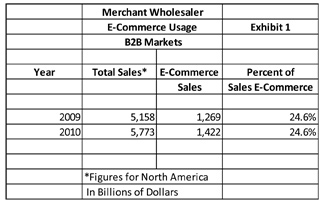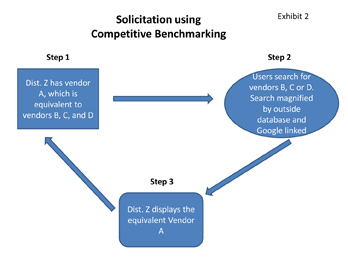E-Commerce: Offensive E-Selling for Distributors
Part One
by Scott Benfield
For distributors, the vast majority of research and recommendations concerning e-commerce center around efficient and effective development of an e-commerce site. E-commerce advice is prevalent especially concerning development of consistent product content and a user friendly site that allows potential customers quick but lasting understanding of the wholesaler’s unique offerings.
Distributors are steadily realizing the need for funding an e-commerce effort with the latest research on adoption of e-commerce by B2B distribution at nearly 25% of total sales.i For both 2009 and 2010, the latest surveyed years, the U.S. Census Economic Report on E-Commerce finds that (Exhibit 1) wholesaler e-commerce sales were 1.4 trillion dollars for 2010, but the percentage of sales was well below manufacturing firms which received 46.4% of their revenues via e-commerce.

The announcement by Amazon Supply in the spring of 2012 and the targeting of the $110 billion MRO sector caught many distributors by surprise. Our research on Amazon Supply found that Amazon can transact a basic stock order for some 60% less than the dominant competitor in the MRO space.ii Amazon has no traditional branches, outside and inside sales forces, or branch managers, and e-commerce is an important vehicle in the firm’s successful entry in the wholesale space.
Many distributors have been content to use e-commerce as an adjunct to the sales effort and as a primary vehicle to reduce inside sales or customer service costs and reduce order entry error while slowly moving customers to increase usage. Our research, experience, and message in this series, however, differs significantly with the current strategy of wholesalers who use e-commerce as complement to the inside sales/order entry function. We believe that the primary advantage of e-commerce as a low-cost and effective solicitation method will, over time, replace an over-reliance on personal selling and inside sales/customer service.
Cost Advantages and New Business Model(s)
E-commerce sale and solicitation, combined with limited service business models, can reduce operating costs substantially with the ensuing marketing strategy to pass along many of these “savings” to the customer. Costs targeted are primarily sales, warehouse, and unique services which typically comprise 40% to 50% of all operating expenses.iii Many of the new models of commerce that use electronic media and e-commerce for transactions are typically not started within the existing distributor community. Many of these Transactional models are started by hard goods “e-tailers” who extend their presence in the wholesale space. Their typical modus operandi is to target the A and B products and larger customers (in revenues) who can purchase larger order sizes and don’t want to pay for sales and solicitation services of their traditional wholesale suppliers. If the larger sales customers are lured away with low pricing on top SKUs, the existing distribution base is left selling C and D and non-stock items.
To date, of the 50 vertical markets serving durable goods distribution, we’ve encountered Transactional models in 12 or roughly 25% of the wholesale space. The Transactional models were started in the last 15 years and have prices 20% to 30% less than full-service distribution. The pricing advantage from Transactional distributors has been explored and verified by researchers from the Harvard Business School and the Boston Consulting Groupiv and corroborates our proprietary research in the wholesale sector. Transactional distributors often have global supply chains and aggressively search for the best acceptable quality at the best price. Transactional firms are also developing unique ways of marketing their cost advantages through e-commerce including competitive cross-referencing.
Using Cross Referencing for Competitive Advantage
The use of product cross-references by distributors is well accepted. In most B2B vertical markets, there are a handful of suppliers of similar form, function, and quality. However, when low-cost global sources averaging 30% or so less in product cost are coupled with advantages of a low-cost distribution model appear, the ability to unseat established high-cost manufacturers who market through a high-cost distribution model is significant.

In Exhibit 2, we illustrate the channel cost advantage for a transactional distributor with a low-cost/acceptable quality vendor using competitive cross referencing. The solicitation process is carried out in five distinct steps including:
- Distributor Z acquires a low-cost line of acceptable quality (A) and puts the SKUs on their e-commerce site. Line A is a direct match for domestic lines B,C, and D. Distributor A develops a robust cross-reference of the dominant suppliers (B,C,D) links them to their low-cost line (A), and places the cross-reference on their e-commerce site.
- Distributor Z magnifies searches for B,C, D by using an outside database of competitive parts with B, C, D SKUs where potential customers conduct product searches. The outside supplier database is linked to Google searches of B,C,D SKUs.
- Distributor Z displays product line A when comparable B,C,and D searches appear and are linked through the competitive cross-reference to their site.
In competitive cross referencing, Distributor Z is successful not only because they have sourced a best-cost SKU, but they magnify their search with an Internet database that carries competitive parts content with added benefits of having a robust, Google-linked search engine for potential buyers. Too, the outside database can prioritize the products of Distributor Z for a slight fee.
Competitive cross-referencing can be enhanced by transaction size discounting where transaction size is driven by discounts and to receive a full freight allowed order. Often freight allowance is based on a breakeven size (in revenues) of a transaction. This practice also improves the chance that new customers will order additional items to receive a larger discount and get pre-paid freight.
Using Outside Databases for Competitive Benchmarking
Traditionally, distributors have been encouraged to develop proprietary product content for their e-commerce efforts. Proprietary, consistent content is a prerequisite, however, there are literally millions of items used in MRO markets and even leviathans such as Grainger or Amazon Supply have 500,000 to 1,000,000 SKUs. Wholesalers can use several sources for an outside database of competitive parts complete with search engine expertise, product benchmarking, and search prioritization.v
The use of outside databases in e-commerce, for independent distributors, is advantageous outside of the cross-referencing capability. Billion dollar wholesalers have the necessary funds and expertise to develop proprietary content and hire e-commerce expertise; the funds to do this for the independent and smaller distributor are not always available and reasonable fees paid to outside suppliers are an increasingly attractive option.
Avoiding Channel Conflict and Other Uses of Competitive Cross-Referencing
Distributors who consider competitive benchmarking of low-cost products cite the potential of significant channel conflict with established vendors. One consideration is to create a separate “distributor” on the web that is not linked, overtly, to the parent distribution firm. Creating a separate site also avoids conflict with sellers and customers of the sponsoring firm.
Competitive benchmarking doesn’t necessarily require a transactional strategy, but we believe low-cost strategies will have the greatest effect using cross-references and allied search engines. For instance, if a traditional distributor has a product with a technology advantage, competitive cross referencing can be used to great effect. Also, if the distributor has a unique service closely tied to identified SKUs, cross referencing can be used in an indexing strategy to link product searches to potential buyers who might use the service.
Establishing a competitive cross-referencing strategy takes preparation including accurate transaction costs including transaction size discounting and transaction breakeven amounts, careful selection of high volume SKUs, close management of the supply chain to ensure a steady supply of competitive product, and the choosing of outside database partners to magnify searches and drive new customer trial. We expect competitive cross-referencing via the web to increase at an increasing rate as distributors look to use the electronic channel to greater effect. However, competitive cross-referencing is not the only means of offensive marketing for distributors and we explore the concept and use of compliant purchasing in the second part of this series.
Scott Benfield is a consultant for B2B channels and can be reached at Scott@BenfieldConsulting.com or (630) 428-9311. Scott’s site can be seen at www.benfieldconsulting.com.
i) www.census.gov/econ/estats/2010/2010reportfinal.pdf May 10, 2012, at U.S. Census Bureau
ii) Benfield, S. Benfield Consulting report to K. Peachway, analyst, July 2012, Grainger vs. Amazon Supply
iii) Benfield, S. Benfield Consulting transaction costing research, 2006-2012
iv) Lal R., Alvarez, J. “Retailing revolution: Category killers on the brink.” HBS Online, October 2011 Hohner, D. “Amazon and Wholesalers,” Boston Consulting Group, October 2012
v) See WayPart at www.WayPart.com or Thomas Net at www.Thomasnet.com













